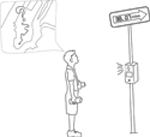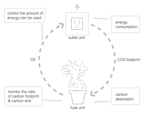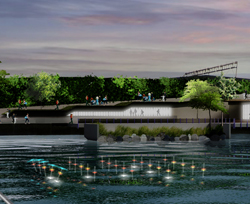An exhibition critically exploring the evolving relations between ubiquitous computing, architecture and the city
September 17 - November 7, 2009
exhibition website: www.sentientcity.net
In September 2009, the Architectural League will present Toward the Sentient City, a major exhibition that will imagine alternative trajectories for how various mobile, embedded, networked, and distributed forms of media, information and communication systems might inform the architecture of urban space and/or influence our behavior within it.
As computing leaves the desktop and spills out onto the sidewalks, streets and public spaces of the city, we are increasingly finding information processing capacity embedded within and distributed throughout the material fabric of everyday urban space. Artifacts and systems we interact with daily collect, store and process information about us, or are activated by our movements and transactions. Pervasive/ubiquitous computing evangelists herald a coming age of urban infrastructure capable of sensing and responding to the events and activities transpiring around them. Imbued with the capacity to remember, correlate and anticipate, this near-future “sentient” city is envisioned as being capable of reflexively monitoring its environment and our behavior within it, becoming an active agent in the organization of everyday life in urban public space.
Few may quibble about “smart” traffic light control systems that more efficiently manage the ebbs and flows of cars, trucks, and busses on our city streets. But some may be irritated when discount coupons for their favorite espresso drink are beamed to their mobile phone as they pass by a Starbucks. And many are likely to protest when they are denied passage through a subway turnstile because it “senses” that their purchasing habits, patterns of movement and current galvanic skin response (GSR) reading happens to match the profile of a terrorist.
Despite the obvious implications for the built environment, architects have been largely absent from the discussions about how these technologies are conceptualized and deployed. To the extent that business interests and government agencies drive these technological developments, we can expect to see new forms of consumption, surveillance and control emerge. Within architecture, the recent fascination with building envelopes wrapped with large-scale programmable “urban screens” or corporate lobbies outfitted with so-called “interactive architecture” highlights the dilemma. In an age of urban computing and ambient informatics, what opportunities for the design of urban artifacts and spaces lie beyond the architectural surface as confectionery spectacle or the interior vestibule as glorified automatic door opener?
Toward the Sentient City will combine a survey of recent work that explores a wide range of context-aware, location-based and otherwise “situated” technologies with a series of commissioned projects by multi-disciplinary teams of architects and artists. The exhibition will examine the broader social, cultural, environmental and political issues within which the development of urban ubiquitous/pervasive computing is itself situated.
ABOUT THE COMMISSIONED PROJECTS

Too Smart City
Key team members: Joo Youn Paek (artist and interaction designer, Artist in Residence, LMCC), David Jimison (founder Mobile Technologies Group, Georgia Tech and Honorary Fellow, Eyebeam)
Too Smart City is a set of street furniture–a trash can, a bench, and an information sign–augmented with computational intelligence and location awareness. In each, the furniture is rendered near useless by its hyper-enthusiastic use of technology to facilitate its service. The result is a comical interactive piece that enables the public to engage in some of the critical issues involved in next generation public infrastructure.

BREAKOUT! Escape from the Office
Key team members: Anthony Townsend (Research Director, Technology Horizons Program, Institute for the Future), Tony Bacigalupo (co-founder, CooperBricolage), Georgia Borden (Associate Director, DEGW), Dennis Crowley (founder dodgeball.com), Laura Forlano (Kauffman Fellow in Law, Information Society Project, Yale Law School), Sean Savage (co-founder, PariSoMa), Dana Spiegel (Executive Director, NYCwireless)
Over a two week period, BREAKOUT! will return creative work to the streets of New York. Using co-working as a model, and injecting lightweight versions of essential office infrastructure into urban public spaces, BREAKOUT! will explore new and productive niches for working outside of traditional office buildings. As the 21st century moves towards a knowledge-based economy, conventional office spaces are becoming obsolete; people no longer need to co-locate in order to access shared tools and resources. BREAKOUT! seeks to create a new architecture for the creative city by appropriating public spaces for the collaborative knowledge work that drives the contemporary city.

Natural Fuse
Key team members: Usman Haque (architect and director, Director, Haque Design + Research), Nitipak Samsen (Designer, Haque Design + Research), Barbara Jasinowicz (Producer, Haque Design + Research)
Natural Fuse creates a city-wide network of electronically-assisted plants that act as carbon-cycle circuit-breakers in much the same way as conventional electrical circuit-breakers do: exceed what the system can handle and the circuit will be broken. Using common house plants, energy-monitoring sensors and the online data-sharing site www.pachube.com, Natural Fuse is intended to help people understand at the micro-scale how energy consumption and carbon offsetting work by attempting to balance the carbon footprint and carbon sink capacity of electricity usage and plants in the system. The project aims to raise awareness of energy expenditure and encourage people to collaborate to share their energy use and nurture their plants.

Trash Track
Key team members: Carlo Ratti (founder SENSEable City Lab, MIT), Rex E. Britter (Professor at Cambridge University, Engineering Department), Stephen Miles (Research Scientist at MIT, Auto-ID Labs), William J. Mitchell (Director MIT Design Laboratory), Valerie M. Thomas (Associate Professor at Georgia Tech and recycling expert), Eugenio Morello (post-doctoral fellow, SENSEable City Lab, MIT), Assaf Biderman (Assistant Director, SENSEable City Lab, MIT), Francesco Calabrese (post-doctoral associate, SENSEable City Lab, MIT), Fabien Girardin (visiting PhD student, SENSEable City Lab, MIT), Aaron Koblin (Interection design and visualization consultant), Armin Linke (Photographer and Video Artist), Christine Outram (research student, MIT), Francisca Rojas (SENSEable PhD candidate, MIT)
Trash Track is inspired by the NYC Green Initiative, which aims to increase the rate of waste recycling in the city to almost 100% by 2030. The project considers how pervasive technologies can help expose the challenges of waste management and sustainability. Trash Track will tag different types of waste and follow these through the city's waste management system to reveal the end-of-life journey of our everyday objects. Whereas most focus in the economic system is on the supply chain, Trash Track will help underscore the environmental impact of consumer waste by visualizing the waste chain, revealing the ultimate destination of the things we throw away.

Amphibious Architecture
David Benjamin (architect, co-director, Living Architecture Lab, Columbia University), Soo-in Yang (architect, co-director, Living Architecture Lab, Columbia University), Natalie Jeremijenko (artist, director, xdesign Environmental Health Clinic, New York University)
Amphibious Architecture will submerge ubiquitous computing into the water, the 90% of the earth’s surface that remains under-explored and under-engaged. Two networks of floating interactive tubes will house a range of sensors below water that will monitor the presence of fish, water quality, and hydrodynamic forces. This data will then be displayed above water using an array of LED lights, along with wireless sensor communication and a text-messaging interface so that citizens can communicate with it from the shoreline. The project will create a dynamic and captivating layer of light above the surface of the river that makes visible the invisible; engages a new ecology of fish, people, buildings, and public space; and sparks public interest and discussion.





